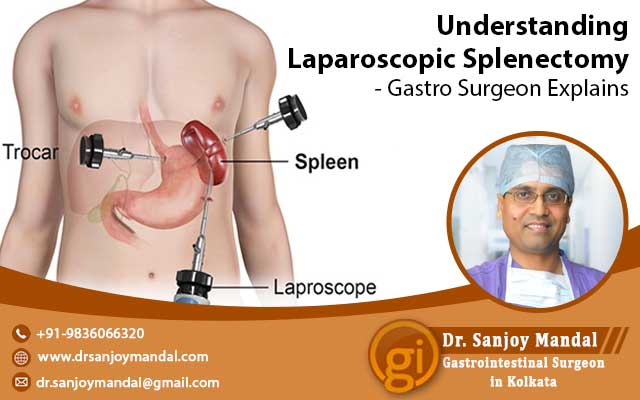Laparoscopic Splenectomy – Overview
The spleen, a sensitive organ located near the stomach and just under the left rib cage, is removed during splenectomy surgery. The spleen is an important organ for the immune system because it contains white blood cells that eliminate invading pathogens and protect the body from infection. It is a place for the creation of red blood cells as well as the filtration and elimination of old ones.
Laparoscopic splenectomy is a less invasive spleen removal procedure that involves four small incisions in the abdomen to allow a small tube with a light and video camera (laparoscope) to reach into the body and display images of the spleen area on a screen. Dr. Sanjoy Mandal, the best gastro surgeon in Kolkata, does the entire procedure using video pictures from the laparoscope.
Why is it necessary for patients to undergo laparoscopic splenectomy
If a patient’s spleen has ruptured and there is severe internal bleeding and unstable vital signs, spleen surgery is required. Splenectomy is also performed when the spleen is affected by malignancy or infection.
Laparoscopic spleen removal has several advantages over standard surgery, such as being less intrusive and hence leaving less scars, as well as a speedier recovery and shorter stay in the hospital.
What are the pre-surgery screening exams and investigations
Prior to surgery, the patient will be required to undergo a thorough physical examination, as well as detailed blood testing and tests to evaluate the chest and abdomen, says the gastrointestinal surgeon in Kolkata. X-rays, electrocardiograms (ECGs), computed tomography (CT) scans, and magnetic resonance imaging (MRI) are among examples.
What is the method for removing the spleen
Patients will be put on a special liquid diet and given medications to clean out their bowels and avoid bacterial infections that may develop following surgery. The condition of fasting must be maintained since the evening before operation.
The patient is given general anaesthetic on the day of operation. The surgeon makes three or four incisions in the belly, one of which is used to introduce the laparoscope. The spleen is brought into front view of the camera by guiding the laparoscope towards it.
Other tools, such as carbon dioxide, are then injected via various incisions to push neighbouring organs away from the spleen, allowing for a better view and space to perform the procedure. The spleen is separated from other organs and blood vessels, and the surgical incisions are closed with sutures by the top gastro surgeon in Kolkata.
What precautions should you take before and after a laparoscopic splenectomy to keep healthy
After surgery, a patient will need to stay in the hospital for a few days. It takes four to six weeks for the patient to fully recover, and he or she must take special care to ensure that the surgical wound heals properly. This involves keeping the wound dry and avoiding vigorous activities such as driving. Patients who are recovering must seek advice from a gastroenterologist surgeon in Kolkata as soon as they become ill so that antibiotics can be prescribed.
